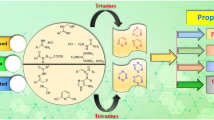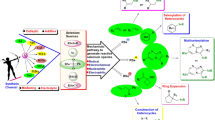Abstract
Two Schiff base ligands FT1 and FT2 and their Cu(II) complexes were synthesized and characterized by 1H NMR, ESI-MS, IR, UV-Visible, Fluorescence spectroscopy, EPR and single-crystal X-ray diffraction studies. FT1 crystallizes in the triclinic system while FT2 in the orthorhombic. The DNA cleavage activity of Cu(II) complexes was studied using plasmid pBR322 DNA by gel electrophoresis. All compounds cleave DNA on photoirradiation by oxidative mechanism.
Graphic abstract
Two Schiff base ligands FT1 and FT2 and their Cu(II) complexes were synthesized and characterized by 1H NMR, ESI-MS, IR, UV-Visible, Fluorescence spectroscopy, EPR and single-crystal X-ray diffraction studies. Both the Cu(II) complexes of indole thiocarbohydrazones are shown to cleave plasmid pBR322 DNA by oxidative mechanism.









Similar content being viewed by others
References
Bose P and Ghosh P 2010 Visible and near-infrared sensing of fluoride by indole conjugated Urea/thiourea ligands Chem. Commun. 46 2962
Yadav B P, Ahmad I and Thakur M 2016 Synthesis of some novel indole derivatives as potential antibacterial, antifungal and antimalarial agents IOSR J. Pharm. 6 27
Kaushik N K, Kaushik N, Attri P, Kumar N, Kim C H, Verma A K and Choi E H 2013 Biomedical Importance of Indoles Molecules 18 6620
Tisato F, Marzano C, Porchia M, Pellai M and Santini C 2010 Copper in diseases and treatments, and copper-based anticancer strategies Med. Res. Rev. 30 708
Heque R A and Salam M A 2016 Synthesis, spectroscopic properties and biological activity of new mono organotin(IV) complexes with 5-bromo-2-hydroxybenzaldehyde-4,4-dimethylthiosemicarbazone Cogent Chem. 1 282
Rapheal P F, Manoj E and Kurup M R P 2007 Copper(II) complexes of N(4)-substituted thiosemicarbazones derived from pyridine-2-carbaldehyde: Crystal structure of a binuclear complex Polyhedron 26 818
Beckford F A, Shaloski J M, Leblanc G, Thessing J, Lewis-Alleyne L C, Holder A A, et al. 2009 Microwave synthesis of mixed ligand diimine–thiosemicarbazone complexes of ruthenium(II): biophysical reactivity and cytotoxicity Dalton Trans. 48 10757
Bhat M A, Al-Omar M A, Raish M, Ansari M A, Abuelizz H A, Bakheit A H and Naglah A M 2018 Indole Derivatives as Cyclooxygenase Inhibitors: Synthesis, Biological Evaluation and Docking Studies Molecules 23 1250
Cheng H, Ying D C, Jie F C, Jiang L Y and Jin M Q 2000 Self-Assembly, Spectroscopic and Electrochemical Studies of Nickel(II)-4,8-Diazaundecanediamide Complex Dalton Trans. 9 1207
El-Sawaf A K, Nassar A F and El-Samanody S 2014 Synthesis, magnetic, spectral and biological studies of copper(II) complexes of 4-Benzoyl-3-methyl-1-phenyl-2-pyrazolin-5-one N(4)-substituted thiosemi-carbazones Sci. J. Chem. 3 17
Sthisha M P, Shetti U N, Revankar V K and Pai K S R 2008 Some Novel Schiff Bases from Pyruvic Acid with Amines Containing N & S Donor Atoms: Synthesis, Spectral Studies and X-Ray Crystal Structures Eur. J. Med. Chem. 43 2338
Chattopadhyay S K and Mak T W 2000 Study of Cu2+ mediated oxidation of thiosemicarbazide, thiocarbohydrazide and thiourea Inorg. Chem. Commun. 3 111
Bacchi A, Bonini A and Carcelli M 1996 Chelating behaviour of methyl 2-pyridyl ketone carbono- and thiocarbonohydrazones in copper(II) and zinc(II) complexes Dalton Trans. 35 185
Zhang N, Tai Y, Li M, Ma P, Zhao J and Niu J 2014 Main group bismuth(iii), gallium(III) and diorganotin(IV) complexes derived from bis(2-acetylpyrazine)thiocarbonohydrazone: synthesis, crystal structures and biological evaluation Dalton Trans. 43 5182
Chitrapriya N, Shin J H, Hwang I H, Kim Y, Kim C and Kim S K 2015 Synthesis, DNA binding profile and DNA cleavage pathway of divalent metal complexes RSC Adv. 5 68067
Mathur N and Bargotya S 2016 DNA – Binding and Cleavage Studies of Macrocyclic Metal Complexes Containing Heteroatomic Ligands Chem. Sci. Trans. 5 117
Viqueira J, Duran M L, Jose A, Vazquez G, Castro J, P-Iglesias C, et al. 2018 Modulating the DNA cleavage ability of copper(II) Schiff bases through ternary complex formation New J. Chem. 42 15170
Jawoor S S, Patil S A and Toragalmath S S 2018 Synthesis and characterization of heteroleptic Schiff base transition metal complexes: a study of anticancer, antimicrobial, DNA cleavage and anti-TB activity J. Coord. Chem. 71 271
Hossain M S, Roy P K, Zakaria C M and Zahan M K E 2018 Selected Schiff base coordination complexes and their microbial application: A review Int. J. Chem. Stud. 6 19
Jia S, Wang R, Wu K, Jiang H and Du Z 2019 Elucidation of the Mechanism of Action for Metal Based Anticancer Drugs by Mass Spectrometry-Based Quantitative Proteomics Molecules 24 581
Sheldrick G M 2015 SHELXT – Integrated space-group and crystal-structure determination Acta Cryst. 71 3
Clegg W 2003 Some guidelines for publishing SHELXL-generated CIF results in Acta Cryst. 59 2
Farrugia L J 1997 ORTEP-3 for Windows - a version of ORTEP-III with a Graphical User Interface (GUI) J. Appl. Cryst. 30 565
Macrae C F, Edgington P R, McCabe P, Pidcock E, Shields G P, Taylor R, et al. 2006 Mercury: visualization and analysis of crystal structures J. Appl. Cryst. 39 453
Spek A L 2003 Single-crystal structure validation with the program PLATON J. Appl. Cryst. 36 7
Xiang D, Zhang R, Liang Y, Pan W, Huang J and Dong D 2007 Vilsmeier−Haack Reactions of 2-Arylamino-3-acetyl-5,6-dihydro-4H-pyrans toward the Synthesis of Highly Substituted Pyridin-2(1H)-ones J. Org. Chem. 72 8593
Bhat S S, Kumbhar A A, Heptullah H, Khan A A, Gobre V V, Gejji S P and Puranik V G 2011 Synthesis, electronic structure, DNA and protein binding, DNA cleavage, and anticancer activity of fluorophore-labeled copper(II) complexes Inorg. Chem. 50 545
Ingle S A, Kate A N, Kumbhar A A, Khan A A, Rao S S and Gejji S P 2015 Synthesis and biological evaluation of copper(II) pyrenethiosemicarbazone RSC Adv. 5 47476
Holland J P, Fisher V, Hickin J A and Peach J M 2010 Synthesis and Biological Evaluation of Copper(II) Pyrenethiosemicarbazone Eur. J. Inorg. Chem. 9 48
Warren L E, Horner S M and Hatfield W E 1972 Chemistry of α-diketone-bis(thiosemicarbazone)copper(II) complexes J. Am. Chem. Soc. 94 6392
Xie D, Kim S, Kohli V, Banerjee A, Yu M, Enriquez J S, et al. 2017 Hypoxia-Responsive 19F MRI Probes with Improved Redox Properties and Biocompatibility Inorg. Chem. 56 6429
Raman N, Johnson R S and Sakthivel A 2007 Synthesis, spectral characterization of Schiff base transition metal complexes: DNA cleavage and antimicrobial activity studies J. Chem. Sci. 119 303
Raman N and Johnson R S 2007 DNA cleavage, structural elucidation and anti-microbial studies of three novel mixed ligand Schiff base complexes of copper(II) J. Serb. Chem. Soc. 72 983
Acknowledgements
Financial support to SSP from Dr. Babasaheb Ambedkar National Research Fellowships (BANRF), Maharashtra, India, and Savitribai Phule Pune University (SPPU) is gratefully acknowledged. The Central Instrumentation Facility (CIF) of Savitribai Phule Pune University is acknowledged for single-crystal X-ray structures and ESI HR-MS. We also acknowledge the Sophisticated Analytical Instrumentation Facility (SAIF) at the Indian Institute of Technology Bombay, Mumbai for EPR measurements. Kind assistance in magnetic susceptibility measurements by Prof. Jayesh Gujarathi, Pratap College, Amalner is gratefully acknowledged.
Author information
Authors and Affiliations
Corresponding author
Additional information
Special Issue on Beyond Classical Chemistry
Supplementary Information
Below is the link to the electronic supplementary material.
Rights and permissions
About this article
Cite this article
Pawar, S., Amate, A., Chakravarty, D. et al. Cu(II) complexes of 2-indole thiocarbohydrazones: synthesis, characterization and DNA cleavage studies. J Chem Sci 133, 107 (2021). https://doi.org/10.1007/s12039-021-01962-x
Received:
Revised:
Accepted:
Published:
DOI: https://doi.org/10.1007/s12039-021-01962-x




